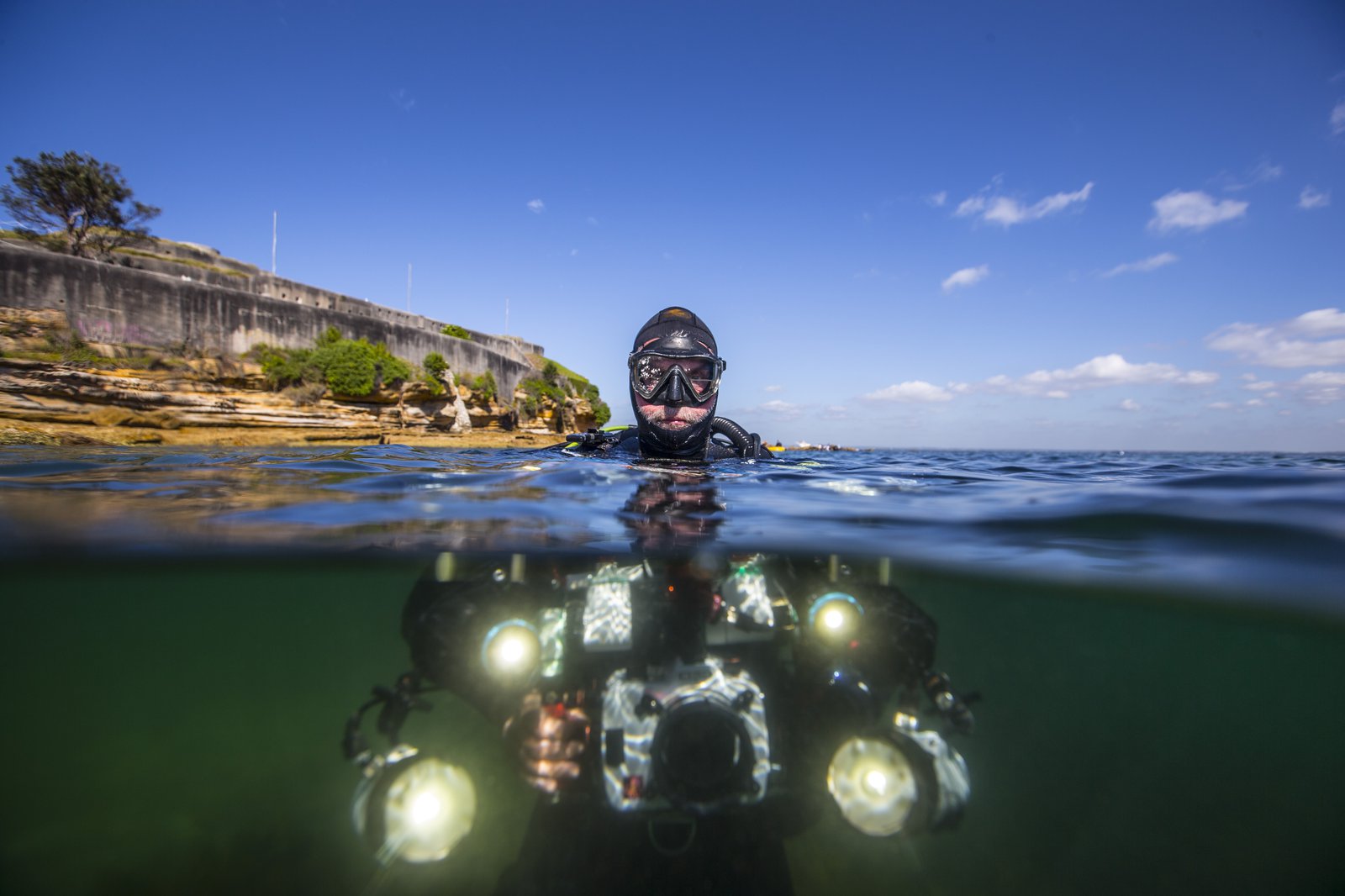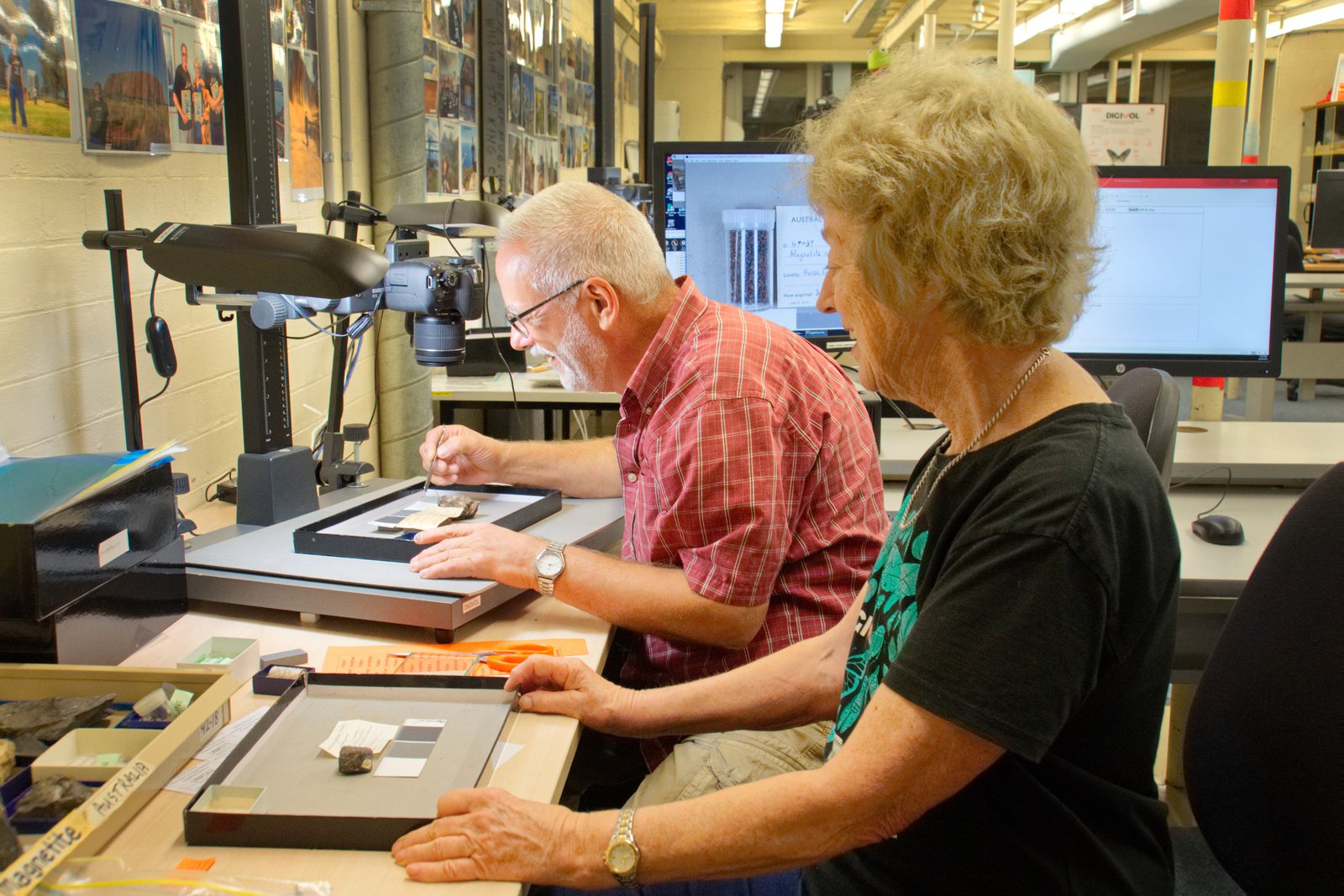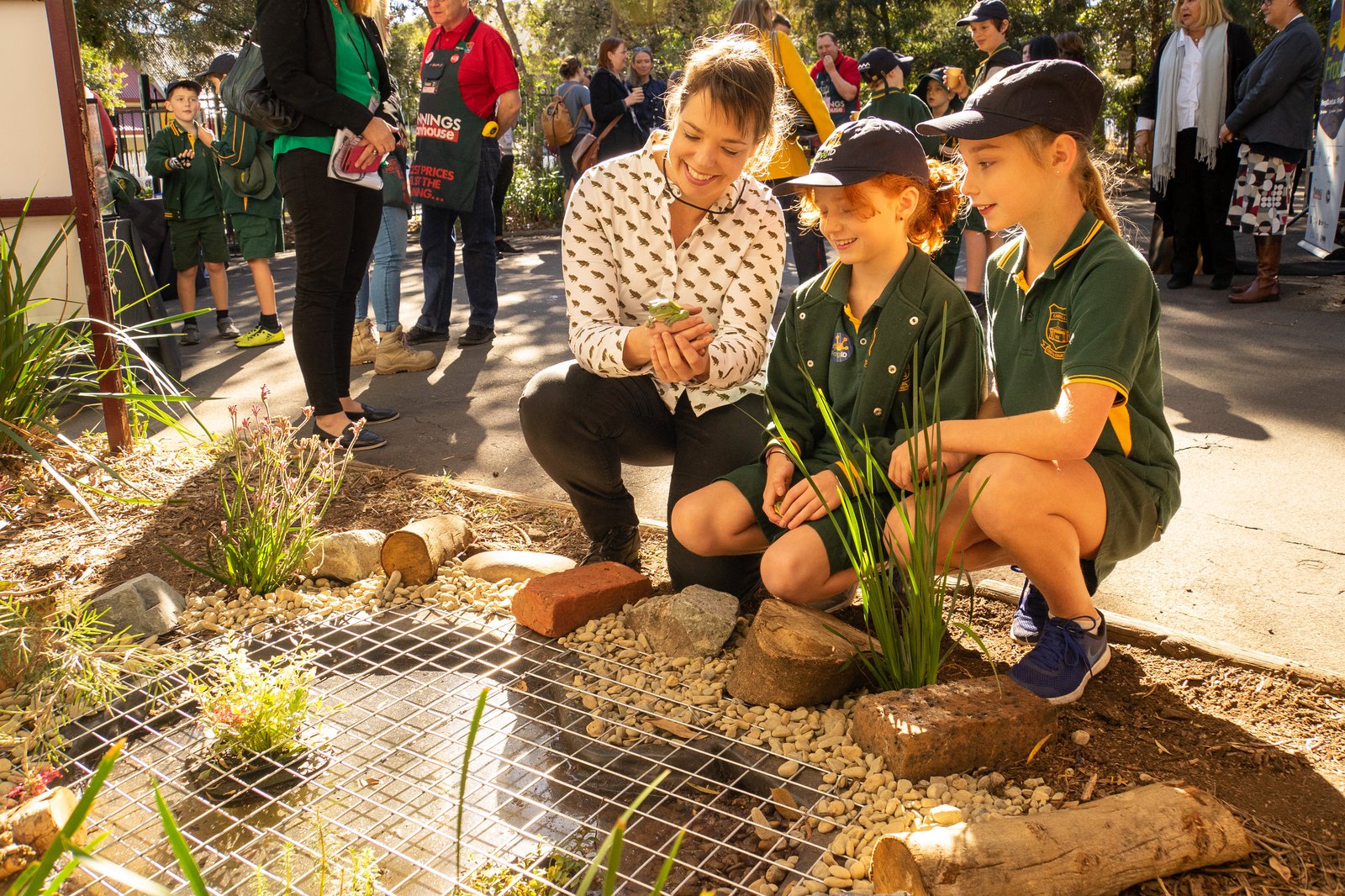Citizens rise!

© Australian Museum
Top frogger
It’s 10pm in Bees Creek, a rural town on Elizabeth River about 30 kilometres south of Darwin. Matt has wheeled the bins out to the top of his driveway. Instead of going straight back inside, he lingers, watching the dry lightning on the horizon.
Matt’s ears adjust to the orchestra of frog calls coming from bushland surrounding his home. He walks back to the house to grab his phone, headlamp and walking stick – to ward off snakes – and heads down to the lagoons. He will spend the next hour recording frog calls for the Australian Museum’s citizen science project, FrogID. Matt’s nights often end up this way – since the launch of FrogID in November 2017, he has become its “top frogger”, single-handedly submitting more than 600 frog call records.
For Matt, a self-described “jack of all trades” with no scientific background, his interest in FrogID was sparked by seeing the destruction wreaked by Cane Toads on native fauna and flora.
“It’s an uphill battle, trying to eradicate the Cane Toads. FrogID is one way I can help the situation. The Cane Toads are massive and protected by thick body armour. And the frogs are so soft and small by comparison – I’ve seen Cane Toads catch and eat frogs in front of my eyes.”
Matt’s 10 hectares is a natural corridor to the Elizabeth River, only one hectare of which is fenced. The rest is left open so that wildlife can access the river. He is passionate about the local ecosystem.
“I’ve always done things for myself. This is something I can do for frogs, for the whole environment. It makes me feel good that I’m not doing it for money.”
The app, developed by the Australian Museum in partnership with IBM, enables anyone with a smartphone in their pocket to plot frog locations. The crowdsourcing initiative enables infinitely more data points to be obtained than a scientist could ever dream of. This approach is revolutionising the research process and it goes right to the heart of what citizen science is all about: regular people making the world a better place.
“Frogs are in trouble and Australia has a pretty bad track record when it comes to frog conservation. We’ve already lost at least four of our 240 known native frog species,” says Dr Jodi Rowley, chief scientist on the FrogID project and curator of amphibian and reptile conservation biology at the Australian Museum Research Institute and University of New South Wales.
“Many more are perched on the edge of extinction, with 29 species of Australian frogs listed as threatened.”
The gaps in our knowledge of native amphibians have made it difficult to protect them. Rowley estimates there are dozens of frog species yet to be officially named or identified, and of the known species, we’re often not sure where they’re distributed, what habitat they require or whether they’re thriving or threatened.
“This is a huge issue. If we don’t know what frogs are where, then we can’t properly take them into account in important land-use decisions, such as where to locate a national park or building development,” Rowley says.
Matt is one of more than 11,000 Australians who have taken up the call to join FrogID. Over 24,000 verified calls of 155 of the country’s 240 known native frogs and Cane Toads have been put on the map – an amazing start to a multi-year project. Volunteers like Matt are driving what is set to become the biggest citizen science project in Australian history.

© ©Australian Museum
Making the world a better place
Presenting the keynote speech at February’s Australian Citizen Science Association Conference in Adelaide, Australia's Chief Scientist Dr Alan Finkel outlined three “big criteria” for any great citizen science endeavour to succeed. Making the world a better place was one of them.
“In the end, that’s what makes it worth doing,” he said. “We often focus on the ‘science’ part of citizen science. But the ‘citizen’ is important as well. It reminds us that we are part of something greater than ourselves.”
The Australian Museum’s Manager of Digital Collections and Citizen Science Paul Flemons agrees that this desire is a major driver of involvement. “Citizens want to make a difference in their community and they’re showing they have the ability to be involved in science,” he says. “Their engagement is being driven by a genuine concern for the local environment, particularly where they feel not enough is being done to protect it. They become involved in monitoring, investigating, documenting and analysing and this can lead to real changes in policy.”
Streamwatch is a citizen science program that enables community groups to monitor the quality and health of their local waterways. Bryan and Margaret Smith are Streamwatch volunteers who help monitor Redbank Creek, a tributary of the Hawkesbury River that they identified as being at risk of pollution from real estate developments. In November 2015, the Smiths notified Hawkesbury City Council of increasing turbidity levels in the creek. Subsequent site inspections revealed unlawful sediment runoff and erosion. The council immediately ordered developers to stop work until controls were put back in place, and the ongoing provision of monthly third-party water-quality assessments. As a condition of ongoing developer activity, the Smiths must also receive these assessments.
“A highlight of our involvement is the opportunity to make a difference by publicly exposing the council’s lack of environmental responsibility towards protecting the creek,” they say.
It’s not just the volunteers who are benefiting; it’s clear the scientists share their enthusiasm. Jodi Rowley of FrogID says, “It’s such an amazing thing to have all these submissions coming in across Australia every night. It’s humbling, but exciting to be part of something so big and so important!”

© Australian Museum
Good data
There’s more to citizen science than tea, cake and community spirit (although those things certainly don’t go astray) – high-quality data also made Finkel’s criteria for successful programs. “Citizen science has to be good science, consistent with the rigorous standards we apply to every other experimental process,” he said.
Practically applied, this means arming volunteers with the knowledge to complete tasks, collect specimens and submit findings accurately.
Technological innovation has gone a long way to improve the quality of citizen scientists’ output by automating and streamlining processes. FrogID owes its national coverage and prolific data collection to an easy-to-use smartphone app. DigiVol, the Australian Museum’s digitisation project, is utilising on-site and online volunteers to photograph its millions of specimens and objects and transcribe their labels, making the collection globally discoverable. And the citizen scientists contributing to Cockatoo Wingtags – a Sydney project held in conjunction with Sydney University and the Royal Botanic Garden Sydney that tracks 140 tagged cockatoos to find out how they are adapting to living in the city – are social media users, posting images of the birds with a designated hashtag.
In the past, scientists have been reluctant to use data collated via citizen science, owing to potential mistakes and unknown variabilities. This is changing, however, as organisations work to improve their processes. For the Australian Museum’s citizen science projects, on-site and online training, instructions, tutorials and easy-to-use workflows are all provided. Some projects, such as DigiVol, also have live forums for volunteers to chat with experts.
“With the right guidance and support,” Flemons says, “there’s no reason why citizen scientists can’t produce the same level of data quality as paid staff.”
In many citizen science projects, professional scientists are at the receiving end of the data, checking volunteer submissions. FrogID has a team of people constantly validating; Jodi Rowley herself listens to hundreds of calls a week to confirm the identity of the recorded frogs. For really difficult recordings – which may be of a rare frog or containing the hoots and croaks of multiple species – two to four people will be on hand to concur. Expert oversight is necessary, Rowley says, but the time required is just a tiny fraction of what it would take if the project was not being crowdsourced.
“I could spend a lifetime trying, without success, to record the call of Spencer’s Burrowing Frog (Platyplectrum spenceri), a species that pops up in the arid zone of Australia and calls after heavy rain, often for only a night or two a year,” Rowley says. “But we’ve already received more recordings of the call of this poorly-known species than I believe have ever existed before now. It’s utterly amazing.”

© Cockatoo Wingtags
A door to the world of science
In every citizen science project, there is “the long tail”: a majority of volunteers contributing casually, and a small number of people who are very passionate and involved. An example of the latter is Megan Edey, DigiVol’s top contributor. A retiree with no background in science, Edey volunteers one day a week in the DigiVol lab, as well as online when at home. Edey is responsible for almost 12% of the total contributions on DigiVol – amounting to just shy of 180,000 data tasks.
Inviting people with no scientific background into the world of science is Finkel’s final criterion for a successful citizen science project.
“Citizen science has to be a door to the world of science… [so that] everyone who enters feels a magnetic attraction to stay. Even if they gave up in science in high school. Especially if they gave up science in high school!”
To illustrate his point, Finkel told the story of what might be Australia’s first citizen science project. In 1847, colonial botanist Ferdinand Mueller used newspaper advertisements to call for volunteers to help him collect specimens of every plant in Australia. The novel project continued for 40 years and involved 1300 Australians.
“One of the women was Mary Kennedy. Imagine her life. She lived on a sheep station in Wilcannia on the Darling River in New South Wales. She was the mother of 11 children. And she collected more than 500 plants for Ferdinand Mueller,” Finkel said.
Democratising science isn’t just about social policy, he argues, but boots on the ground and a willingness to get dirty.
“Ferdinand Mueller wasn’t particularly interested in social policy. He was an opportunist, plain and simple! He recruited kids because they were enthusiastic and happy to wade through mud. He recruited women because he saw their talent going to waste.”

© Australian Museum
The future of citizen science
In coming years, having people on the ground will be essential to understanding the impact of our rapidly changing climate. So the increase in the popularity of citizen science, helped in no small way by advances in technology, is a great advantage to the science and research community.
What will citizen science’s impact be in the 21st century? One thing is for sure – the relationship between society and science will only grow stronger. Society will continue to be enriched by the reinvigoration of scientific curiosity. Paul Flemons hopes that through hands-on experiences, people will be inspired by nature and pass on that appreciation to their friends and children. They will be motivated by seeing that change at the highest level is possible because of their contributions.
“I also think citizen scientists will increasingly be involved, not just in data collection, but in initiating and co-creating projects with professional scientists,” Flemons says.
Science will benefit from large-scale, long-term projects that would otherwise be impossible to conduct. Scientists hope that public engagement and changing attitudes will encourage governments to increase funding of science. That citizen science will enable scientific discoveries that affect legislation, the protection of national and marine parks, and the investment in innovative strategies to halt the effects of climate change.
It seems that the future really is in our hands.
***
Get involved in the AM’s citizen science projects!
FrogID
Download the app and join the nation-wide challenge to record the calls of Australian frogs. Click here
Digivol
Unlock the secrets of the Australian Museum collections and those of institutions all over the world by helping digitise objects and specimens and their labels.
Australasian Fishes
Upload your underwater images of fishes and help us learn more about their populations.
Cockatoo Wingtags
Record your sightings of cockies with yellow tags and contribute to our knowledge of their habits.
Hollows for Homes
Register hollows in Sydney’s trees and assist in protecting the homes of local wildlife.
Streamwatch
Connect with volunteers in your local area and keep waterways healthy.

